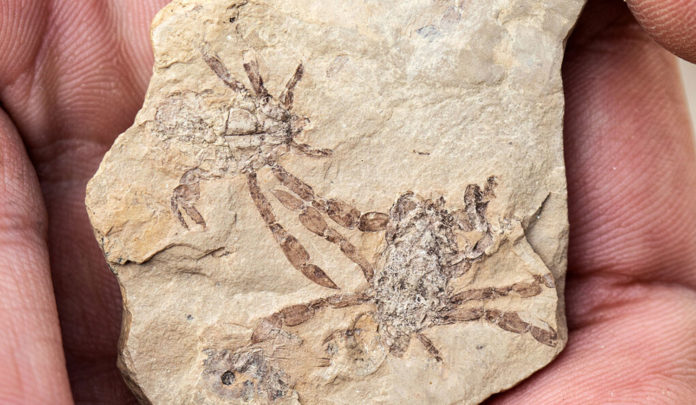Paleontologists from Yale and Harvard have discovered new, unusually large optical features from a 95-million-year-old crab fossil. They studied a crab fossil named Callichimaera perplexa.
In 2019, former Yale paleontologist Javier Luque described the species, suggesting that the Callichimaera was a C. perplexa.
Callichimaera perplexa possessed remarkably large eyes and a disparate body form among brachyurans. It has bent claws, leg-like mouthparts, an exposed tail, and a long body.
A previous study suggested it was the earliest example of a swimming arthropod with paddle-like legs since the extinction of sea scorpions more than 250 million years ago.
Kelsey Jenkins, a graduate student in Earth & planetary sciences at Yale and the new study’s first author, said, “The specimens we have of the unusual Cretaceous crab Callichimaera perplexa preserve some very delicate eye tissues that don’t normally preserve. This includes things like facets and internal optical tissues. This kind of excellent preservation is rare.”
For the study, scientists analyzed nearly 1,000 living crabs and fossils. The crabs involved- were at different stages of development, representing 15 crab species. Scientists then compared the size of the crabs’ eyes and how fast they grew.
Callichimaera topped the list in both categories. Its eyes were about 16% of its body size.
Jenkins said, “I’m 5’2″. If my eyes were this big, they’d be a little over 9 inches in diameter. If something has eyes this big, they’re very highly visual. This is in stark contrast to crabs with tiny, vestigial eyes where they may only be 1 to 3% of the animal’s body size.”
Scientists found that the Callichimaera’s optical growth rate was faster than any crab.
The study’s co-author is Derek Briggs, who said, “Crabs whose eyes are growing very quickly are more visually inclined — likely they’re very good predators who use their eyes when hunting — whereas slow-growing eyes tend to be found in scavenger crabs that are less visually reliant.”
Jenkins said, “Tellingly, it was a fresh set of eyes that made the latest Callichimaera finding possible.”
“Javier and Derek mentored me, and I was able to provide an outsider’s perspective on a group of animals I was originally unfamiliar with.”
Journal Reference:
- Kelsey M. Jenkins et al. The remarkable visual system of a Cretaceous crab. iScience, 2022; DOI: 10.1016/j.isci.2021.1iscience03579
